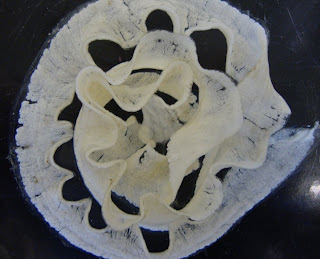Nassarius fossatus is a marine snail. Snails, or gastropods, belong to the Spiralia - a large group of animals with spiral cleavage.
Nassarius fossatus has unequal cleavage, which means that one of the cells at the two-cell and four-cell stage is larger than the others. The first four cells in a spiralian embryo are denoted as A, B, C and D. The D cell is the largest in unequal spiral cleavage. There are several mechanisms by which unequal cleavage can be accomplished.
Nassarius does this via the so-called
polar lobe, which is shown in these pictures. A polar lobe is an anucleated protuberance which forms at the vegetal pole during first, second, and sometimes subsequent cell divisions. It then fuses with one of the cells, making it larger than the others.




The top picture shows polar lobe formation during the first cell division. One can see two
polar bodies. Polar bodies are the tiny sister cells of the oocyte which are produced during meiosis, contain discarded DNA and mark the
animal pole of the embryo (up in the first three pictures). The opposite pole of the embryo is the
vegetal pole. The two cells at the animal pole are the first two blastomeres. What looks like a third cell at the vegetal pole is the polar lobe, which at this stage is nearly completely cinched off from either blastomere. Subsequently the polar lobe fuses with one of the blastomeres (second picture from top), so that by the end of the first cell division one of the blastomeres (called CD) is noticeably larger than the AB cell (third picture from top). Polar lobe also forms at the second cell division (not shown). At the four-cell stage blastomere D is the largest, blastomere C is the second largest, while A and B cells are about the same size (bottom picture). The first three pictures are lateral views, while the bottom picture is a polar view. It is the first time I have heard of and observed unequal spiral cleavage, and I think it is remarkable. I also liked these eggs because the egg capsules they are laid in are very beautiful when viewed under the dissecting microscope (see
picture by Janelle Urioste).
 This is the brachiolaria larva of a starfish, Pisaster ochraceous,that I raised during the Embryology class. Larval anterior end is up, and you are looking at the ventral side. The brachiolaria is characterized by the presence of brachiolar arms and an adhesive disk, and the bottom image shows a close up of the pre-oral protuberance of the frontal lobe that bears these structures. The brachiolaria larva follows the bipinnaria larval stage in the forcipulates, a group of starfish.
This is the brachiolaria larva of a starfish, Pisaster ochraceous,that I raised during the Embryology class. Larval anterior end is up, and you are looking at the ventral side. The brachiolaria is characterized by the presence of brachiolar arms and an adhesive disk, and the bottom image shows a close up of the pre-oral protuberance of the frontal lobe that bears these structures. The brachiolaria larva follows the bipinnaria larval stage in the forcipulates, a group of starfish.  The brachiolaria is the last larval stage in these asteroids. It is characterized by three brachiolar arms (the three stubby arm buds near the top of the larva in the first image and zoomed in on in the second image) which surround a central adhesive disk (the brown spot between the lower two brachiolar arms in both images). These appendages have sticky cells and are used to make contact with the substratum when the larva is competent to settle. Some other asteroids, that have lecithotrophic, or non-feeding development, skip the bipinnaria stage, and directly produce large yolky brachiolaria with three brachiolar arms and an adhesive disk also used for settlement and attachment.
The brachiolaria is the last larval stage in these asteroids. It is characterized by three brachiolar arms (the three stubby arm buds near the top of the larva in the first image and zoomed in on in the second image) which surround a central adhesive disk (the brown spot between the lower two brachiolar arms in both images). These appendages have sticky cells and are used to make contact with the substratum when the larva is competent to settle. Some other asteroids, that have lecithotrophic, or non-feeding development, skip the bipinnaria stage, and directly produce large yolky brachiolaria with three brachiolar arms and an adhesive disk also used for settlement and attachment.


















